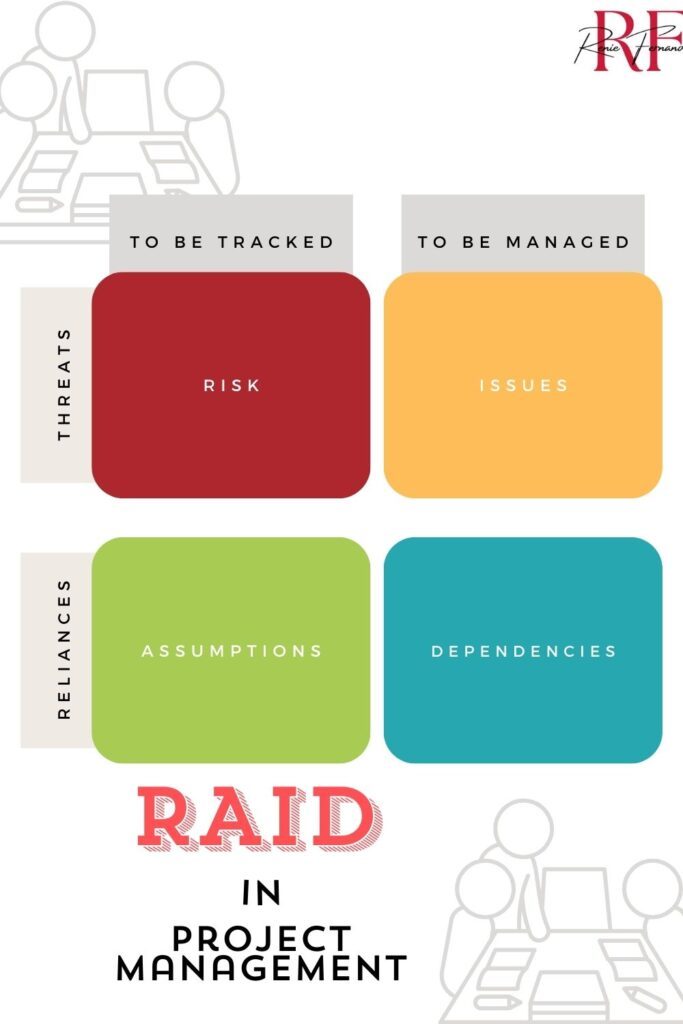READ TIME: 5 minutes
Today, let’s dive into the wonderful world of RAID in project management. Whether you’re managing a construction project or a business venture, understanding RAID can help you stay on top of things and navigate challenges like a pro.
What is RAID in Project Management?
RAID stands for Risks, Assumptions, Issues, and Dependencies. It’s a tool that project managers use to track and manage key project elements. RAID helps identify potential pitfalls and ensures you have plans to address them.
The Purpose of RAID
Think of RAID in project management as the analysis that helps teams create a strategy for avoiding events and issues that may harm the project’s outcomes.
The purpose of RAID is to provide a clear framework to identify, track, and manage key project components. By maintaining a RAID log, project managers can keep stakeholders informed and make better decisions.
Using RAID in Construction and Business Projects
RAID is crucial because it provides a structured approach to manage uncertainties. It helps in proactive risk management, keeps the team focused on critical issues, and ensures dependencies are managed effectively. RAID also improves stakeholder communication by providing a clear overview of project status.
In construction projects, RAID helps in tracking risks like delays due to weather or supply issues. It ensures all assumptions about site conditions are documented, issues are resolved promptly, and dependencies between tasks are clear.
In business projects, RAID helps in tracking market risks, ensuring assumptions about market trends are documented, addressing operational issues, and managing dependencies between different business functions.
A RAID log typically includes:
- Risks : Potential problems that might affect the project.
- Assumptions: Conditions believed to be true for planning purposes.
- Issues: Current problems that need to be addressed.
- Dependencies: Tasks or events that depend on the completion of other tasks.

Pros and Cons of RAID
Like everything, having and maintaining a RAID in project management has its pros and cons.
Pros:
- Provides a clear framework for risk management.
- Enhances communication with stakeholders.
- Helps in proactive issue resolution.
- Ensures dependencies are managed effectively.
Cons:
- Can be time-consuming to maintain.
- Requires regular updates and reviews.
- May become overly complex in large projects.
Common Terms in RAID
- RAID Register: A document where all RAID elements are recorded.
- RAG Reporting: A status reporting method using Red, Amber, and Green indicators.
- Project Artefacts: Documents and materials produced during the project.
- Stakeholder Engagement: Involving stakeholders in project decisions and activities.
- Communication: The exchange of information between project team members and stakeholders.
Steps to Implement RAID in a Project
- Identify RAID Elements: Start by identifying risks, assumptions, issues, and dependencies.
- Create a RAID Log: Document each element in a RAID log.
- Assign Responsibilities: Assign team members to manage each RAID element.
- Review Regularly: Schedule regular reviews of the RAID log to update and address elements.
- Communicate: Share the RAID log with stakeholders and keep them informed.
Creating a RAID Log
Creating a RAID log is straightforward. Here’s a step-by-step guide:
- Use any word processing software like Microsoft Word, or Google Docs, or even Microsoft Excel to create a RAID document. Various other project management software like Wrike, Asana, etc help in creating RAID logs.
- Create a Table with columns for the RAID elements.
- Label columns as Risk, Assumption, Issue, and Dependency.
- Fill in details for each RAID element.
- Ensure the log is updated regularly.
- To ensure document version control, add a date to the file name. If the RAID log is created in Microsoft Excel, then duplicate the tab, saving it with a new date.
Final Thoughts
Understanding and implementing RAID in project management can help you manage risks, assumptions, issues, and dependencies effectively. This structured approach aids in handling uncertainties and ensuring project success. First, decide if you need a RAID analysis. If yes, then start working on it in your planning phase, making it as detailed as necessary to match your project’s complexity, allowing for frequent updates to keep everything on track.
Remember, the level of detail in your RAID logs is up to you, and your organisation’s project management procedures.
Tools and Resources to Make the next Move
If you are ready to take action, here are some books, articles, and tools to help you move forward:
Books:
-
-
Project Management: A Systems Approach to Planning, Scheduling, and Controlling, by Harold Kerzner
-
Construction Management: From Project Concept to Completion, by Paul Netscher
-
A Guide to the Project Management Body of Knowledge (PMBOK® Guide), by Project Management Institute
Things to Buy:
- A quality journal – Writing things down brings clarity and commitment.
- A whiteboard or sticky notes – Great for mapping out ideas and tracking progress.
- A timer – Helps with focus and consistency when taking small daily actions.
Articles:
- Why Women Don’t Apply for Jobs Unless They’re 100% Qualified – Harvard Business Review.
- How to Overcome Fear of Failure and Take Action – Psychology Today.
- The Power of Small Wins – Harvard Business Review.
🔥 Ready to Start Your Reinvention?
📩 DM me “READY” on Instagram for a free strategy session.
🗓️ Or book your spot directly



